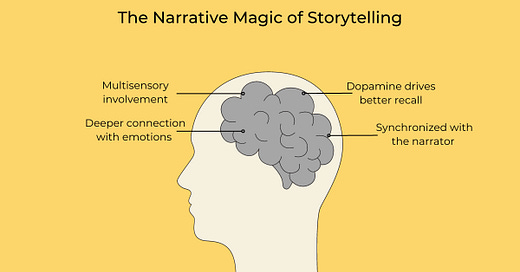I have spent hours as a child listening to my parents narrate stories. Stories were an integral part of meals and bedtime routines. The stories were woven in morals and lessons. There was something to learn from every character in the story. It was transformational.
Why are stories magical? It’s in the details. Storytelling is a holistic experience for the learner. It touches various regions of the brain, thereby improving the learning experience, memory retention, and recall.
Scientific research has shed light on how our brains are wired to learn better through stories. In a study published by the Journal of Cognitive Neuroscience, scientists uncovered that our brain relates most to the characters in a story rather than the plot.
In this article, we will delve into the value of storytelling in learning, examine the scientific evidence supporting its efficacy, and provide actionable insights to learn better.
Storytelling activates various regions of the brain, resulting in a more comprehensive and long-lasting learning experience. The study found that stories engage multiple sensory and motor areas, enabling the brain to process information more effectively.
Furthermore, storytelling triggers the release of neurochemicals, such as dopamine and oxytocin, which are associated with increased attention and enhanced memory consolidation. This chemical response reinforces the brain's ability to retain and recall information presented in a narrative format.
There are three cognitive advantages of storytelling:
1. Engaging and Memorable
Stories create an immersive learning environment that captivates learners' attention. By capturing information in a narrative form, you are more likely to retain information embedded in a story due to the emotional resonance it evokes.
2. Contextualizing Complex Concepts
Abstract or complex concepts can be challenging to grasp, but storytelling provides a bridge between new knowledge and existing understanding. By placing information within a narrative context, you can better comprehend and integrate new concepts, as stories offer relatable scenarios that make the subject matter more tangible and applicable.
3. Fostering Critical Thinking
Stories stimulate critical thinking by presenting characters with dilemmas or challenges. Stories encourage you to analyze situations, evaluate different perspectives, and develop problem-solving skills. Story-based learning nurtures your ability to think critically, fostering creativity and independent thought.
How do we embrace storytelling to learn better?
a. Structure your learning
The structure of a story includes a beginning, middle, and end which makes the learning experience personal and learner-centric. This structure helps you organize and mentally categorize information, aiding comprehension and retention.
Structure your learning experience with the following:
Why is this learning experience valuable?
What are your goals as a learner?
How do I reflect on my progress?
b. Characters over Plot
Instead of focusing on the plot of the learning experience, albeit the ‘HOW’, begin your learning experience with ‘WHO’ and ‘WHY’. It is essential to focus on the feelings of the characters in the learning experience.
For example:
Learning piano is going to make me feel __________.
Learning a new language at 60 makes me __________.
I feel ________ to go to my zumba class.
Emotions make the learning experience magical.
c. Reflection
The magic of storytelling is in the tail end where you think about the characters, how they reacted to the events, and your lessons. Three little pigs and the Wolf taught us about the value of dedication and doing things the right way, even if they take time. Morals of a story are like mirrors - you learn through the characters’ experiences and empathize with their pain, gains, and lessons.
Reflection is not a formula, but a ritual. Start with the goal and understand the gaps. This will lead to a unique reflective practice that suits you.
Learning through storytelling is more about the characters, that is you the learner, and less about the plot, the learning experience. Let’s learn to prioritize the learner before anything else.
Unlearning Thought
A ball of yarn can be untangled in different ways. It’s the same with stories and how we relate to them.
Hey there!
I am a teacher→learning designer→product manager + founder at Unlearning Labs. I’d love to chat about - product, edtech, learning. Set up a time and let’s get some coffee.




